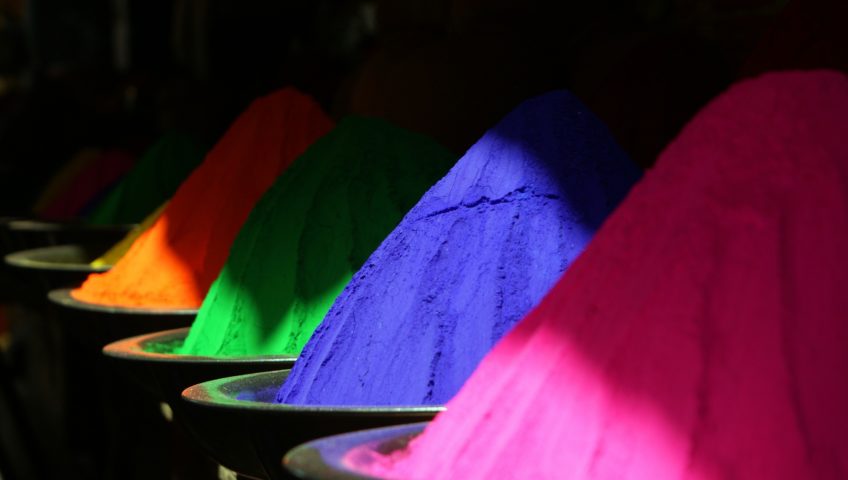
Colors of Interior
Because office space is the most frequent intended use of modular buildings, we would like to discuss hints for choosing the right color palette when dealing with the interior design of an office.
Colors generally divide into warm and cool. Using warm colors within the room will make it appear crosier and visually smaller. Those colors will imitate heat and energy. The larger the wall painted in a warm color the stronger the impression of warmth and coziness.
Cool colors will visually enlarge the room. The room will appear colder but also soothing and calming and those are often good reasons to use cool colors for.
When looking at the color wheel, warm colors are generally those areas of red, orange through to yellow hues. Hues of brown are also considered warm.
Cool colors are considered to be hues of green, blue through to violet. White, black and grey are considered to be neutral.
As a rule, it is not advised to use only warm or only cool colors. When using warm color as a base, it is good to add some cool colored details and vice versa.
Office space is often used to greet clients. Cool colors will make an office seem professional but if too many in use, an office will seem uninviting and cold. Hence a good rule for the office environment would be to use a base color which is either neutral or cool and add other colors which will be generally in warm or mixed hues of warm and cool colors to warm up space.
For the purpose of this article, we decided to divide colors of our interior design into three categories; base color, colors of details and finishing color.
Design Recipe; professional, refreshing and inviting office = one cool/neutral base color + two warm (or a warm and a cool) colors of details + (optional) one finishing color to give the space more edge.
When using a base color we are thinking of large areas such as walls, floor, ceiling and tables.
When using colors of details we are thinking of chairs, small carpet, picture frames or advertising material on walls, stationery items, lamps, small design detail painted on wall (lines, dots), maybe text with the name of the company or perhaps one wall designated to one of the colors of details while other walls stay in base color. Colors of details are at least two so it is great fun to play with the amount of those two colors when choosing items for the space (example; stationery items and lamps in one color while picture frames on walls and a carpet in another).
When using finishing color we are thinking of an accent, a cherry on a cake. It could be stationery item additional to those which are already there, it could be one or two design highlights (line or dot painted on a wall) next to those which are already there, it could also be a lamp provided that other lamps are in different color.
When choosing any hue as a base color, it is good to go for its lightest version as it will appear professional, fresh and inviting instead of heavy and dark. Colors of details may be chosen in different shades, darker or lighter, depending on preference:
White – neutral color. When used as a base color, it will appear clean, fresh and open. White will need quite a few items in other colors otherwise it may appear as highly sterile. Accompanied details in yellow + violet or green + red will create an energetic, inviting and refreshing atmosphere. In fact, it is enough to choose any two colors opposite each other on the color wheel and add it to white base color to create a good combination.
Light-grey – neutral color. As a base color for office walls, it will appear professional and serious. Items in colors of details will not have to be as many as when using white. Light-grey is very nice as a background for other colors because it reflects them back. Orange + blue or yellow + violet would suit as colors of details for light-grey (great finishing color here could be white). Choosing any two colors opposite each other on the color wheel and adding it to light-grey should be a good combination as long as one of them will be a vibrant rich hue.
Light-blue – is a cool and soothing base color appearing as calm and refreshing. Items in colors of details added to light-blue will need not to be too many if wanting to keep the professional and serious feel of the space. Adding yellow-green + red-orange as colors of details will break it down nicely (black could be good finishing color here).
Light-green – is another good cool base color. Light-green will create calming and inviting environment for both clients and employees. When using green, it is important to not overdo it with items in other colors. Good choice for colors of details when using green would be violet + orange.
Light-violet – is also cool color. As a base color, it will also need small amounts of items in other colors. Good detail colors for light-violet would be green + orange (good finishing color for this combination could be black or white).
Our five favorite finishing colors for an office space are white, dark-grey, black, silver and gold. The most important rule to remember when it comes to finishing color is that it must be different than all other colors already used as well as it needs to be present in very small amounts. It serves as a highlight.
Therefore in case of white being chosen as a base color, it cannot be chosen as a finishing color.
White could serve as finishing color when base color was chosen to be light-grey, light-blue, light-green or light-violet.
Silver as a finishing color will emanate wealth, technology as well as elegance and gold will emanate elegance and wealth particularly when used with white as a base color.
It is worth to take samples of all five finishing colors and to visually check which one matches best to our design. When in doubt we could simply choose black or white as these are neutral colors and should match almost any design.
That will be all, for now, when it comes to colors of interiors. More to come on design hints and colors in the near future.

Write a Comment